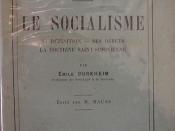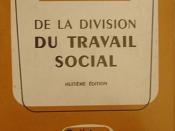SECTION ONE: PROBLEM STATEMENT One of the fundamental premises of urban ecology applied to development in the United States is that urbanization has occurred as a result of the migration of a large and varied population of workers into specific regions of the country because of industrialization (See Text). The development of many of the urban centers in the United States can be directly tied to the industrial expansion of the 19th and early 20th centuries and the progression of urban centers had a notable impact on communities, social interactions, societal norms, public opinion and even self-concept (See Tonnies, 1963 as cited in Text). Further, Tonnies (1963) argued that the urbanization and development of the large cities was putting an end to the close-knit communities of the small town, and that these kind of connections could not occur within the urbanized society.
Emile Durkheim argued it was not location that connected individuals, but a sense of similarity and culture that defined the values and social constructs of a community.
As a result, Durkheim would contend that even in the modernizing world, it is possible in the urban setting for individuals who share common backgrounds, cultures, values and religions to demonstrate a level of solidarity without the necessary dictums of the rural community. Durkheim's notion of "organic solidarity," then, stemmed from the acceptance of the viability of these communities within the larger urban setting (See Text).
Chicago School theorists, including Robert Park, Ernest Burgess, Homer Hoyt, and Georg Simmel, considered the specific development of the communities in the urban setting and the elements that determined the creation of the modern slum. Applying the theories of these sociologists to the development of Jewish and African American communities in urban settings like Baltimore underscores the link between manufacturing and industrial development in Baltimore...


